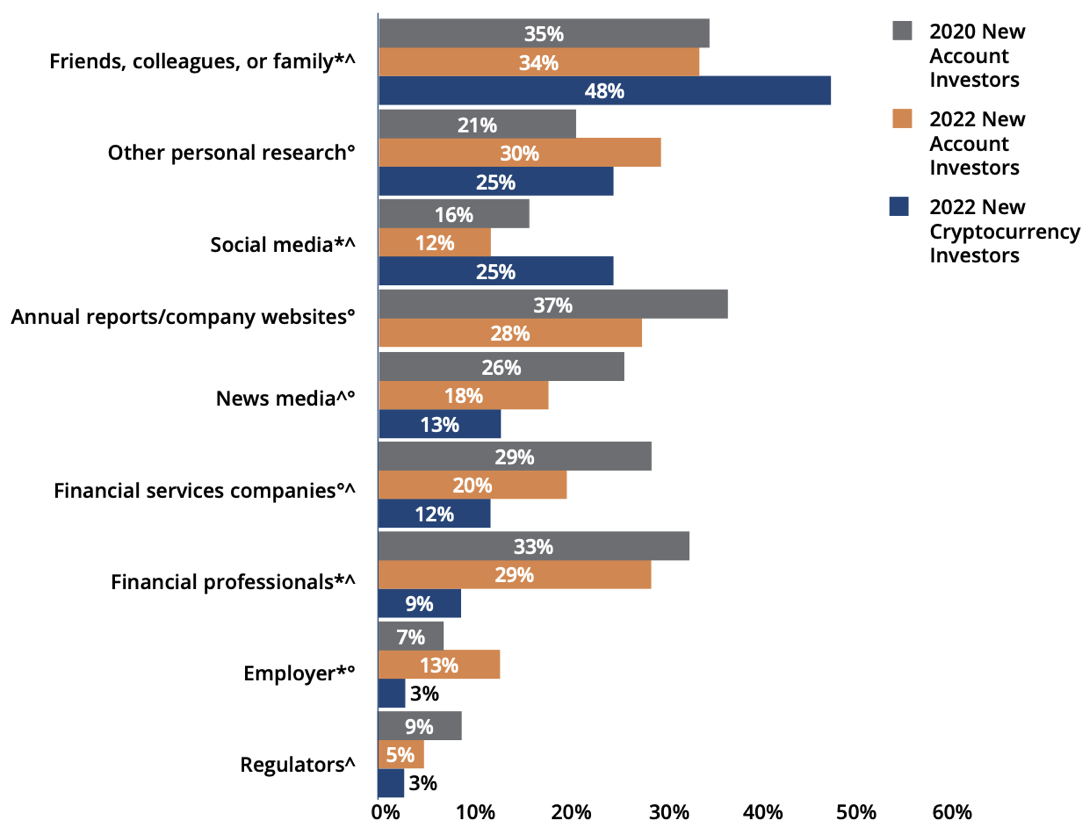Join Our Telegram channel to stay up to date on breaking news coverage
A recent survey by the United States Financial Industry Regulatory Authority (FINRA) Investor Education Foundation has shed light on the reasons why new investors have started buying cryptocurrency in 2022.
Friend Suggestion and FOMO Top Reasons for First-Time Crypto Investors
The survey found that 31% of new cryptocurrency investors cited “friend suggestion” as the primary reason for their foray into crypto. In comparison, only 8% of first-time equities or bond investors mentioned this as their motivation, indicating that there is “a social element to cryptocurrency investing not evident in equities or bond investing.”
In addition to friend suggestions, the ability to start with small amounts of money was the second-biggest reason for entering the crypto market, at 24%, which is similar to the reasons why equities and bond investors start investing.
It’s interesting to note that about 10% of people surveyed said they bought cryptocurrency for the first time because they were afraid of missing out on a chance to make some money. This is popularly referred to as FOMO in the crypto community.
According to the survey, almost half of the crypto investors said that they get information about cryptocurrencies from friends, family, or colleagues at work.
Social media was the next most common source of information, with 25% of respondents saying they learn about the crypto market from these platforms. This suggests that many people who are new to crypto are relying on these sources to understand more about it.
The study discovered that younger people, with an average age of 37, were more likely to invest in cryptocurrency, and they were less likely to have a four-year college degree, with only 28.5% having completed one. On the other hand, stock investors were older, with an average age of 43, and better educated, with 46.3% having a college degree.
Surprisingly, the study found that digital asset owners didn’t know as much about cryptocurrencies as they initially thought. Digital asset investors scored only 26.6% on a five-item quiz that asked questions about how a cryptocurrency is issued, transferred into US dollars, taxed, and how transactions may be susceptible to fraud.
Overall, the survey shows that the social element and influence of friends and family are strong drivers of new investors entering the crypto market, with many relying on these sources for information. It also suggests that many new investors may not fully understand the complexities of cryptocurrency and the risks involved.
Crypto Adoption In Europe Increases Amidst Struggling Market
The use of cryptocurrency in Europe has been steadily increasing, but there are significant gender gaps in its ownership.
In the UK, only a small number of respondents in a survey conducted in March 2022 claimed to own cryptocurrency, with Bitcoin being the preferred cryptocurrency. Similarly, in Germany, the percentage of people who owned cryptocurrency was only a few points higher than those who planned to invest in it in the future.
However, among those who had already invested in cryptocurrency, nearly half of them planned to increase their investments in the next six months. In France, Bitcoin remained the most popular currency among those who had invested in cryptocurrency or planned to do so, including NFTs.
Switzerland had over 50% of its crypto investors inclined towards buying and holding crypto, with Bitcoin as their top preference. On the other hand, Europe has experienced a surge in the implementation of stringent regulations on cryptocurrency, despite its increasing adoption.
During the first half of 2022, over 50% of surveyed individuals who owned cryptocurrency expressed their desire to increase their holdings within the next year. This sentiment was more prominent among younger age groups than older generations. Bitcoin and Ethereum were the preferred cryptocurrencies during this period.
However, the cryptocurrency market suffered a decline in value starting in the spring of 2022, resulting in investor enthusiasm loss and negative asset price movements across Europe.
FTX’s fall and BlockFi’s bankruptcy led lawmakers in Europe to agree on implementing licensing and supervision rules by 2024 to ensure consumer protection, market integrity, and financial stability.
The crypto crash had varying impacts across Europe, with countries such as Cyprus being hit harder than others due to a lack of national regulations. Nonetheless, Germany, the Netherlands, and France saw limited impacts thanks to their national regulations that shielded them from severe losses.
Will Central Bank Digital Currencies Catalyze Cryptocurrency Adoption?
We are now in a period of stagflation, with central banks – specifically the Fed – making decisions that could do more harm than good.
The Fed has already spent a considerable amount of money on quantitative easing during the pandemic, but it now seems that they are focusing on fighting inflation by raising interest rates and potentially using quantitative tightening (QT).
These decisions have created an opportunity for those with cash to purchase assets from those who are less well-off and have to sell. This has resulted in an unbalanced economy where too much is given to those who don’t need it, while those who do have to spend get very little. This can be improved if central banks target nominal GDP instead of inflation and institute mild QE while lowering interest rates.
On the other hand, the consequences of continuing with the current path could result in a recession. For instance, in the next two years, over $3 trillion of property loans in the US are expected to be refinanced, resulting in a -40% drop in commercial property values.
Investors are piling into cryptocurrencies as a hedge against what they perceive as a problem in the fiat world. It remains to be seen if this trend will continue. However, it’s likely that central banks worldwide will be implementing Central Bank Digital Currencies (CBDCs) to airdrop tokens like Bitcoin directly into people’s wallets. This move will simplify the process and ensure that the needful can spend while those well-off can’t save or earn interest on it.
This could very likely make cryptocurrencies more accessible to a wider section of the demographic. Plus, an institutional currency will help instill confidence in the CBDC and therefore promote further adoption. As for now, investors can keep their eye on further surveys to keep themselves updated on factors influencing cryptocurrency adoption.
Related Articles
Join Our Telegram channel to stay up to date on breaking news coverage



